Historic Preservation in Boulder: A Community Commitment

Understanding Historic Preservation and Its Importance
Historic preservation involves protecting and maintaining buildings, sites, and structures that hold historical significance. It plays a vital role in preserving a community's identity and heritage, allowing future generations to connect with their past. In Boulder, this commitment is evident through various initiatives aimed at safeguarding the city’s unique architectural and cultural narratives.
Preservation is a form of protest against the loss of our cultural identity.
The importance of historic preservation can be likened to keeping a family photo album intact. Just as those photos tell the story of a family's journey, preserved buildings reflect the community's evolution and shared experiences. By valuing these structures, Boulder not only honors its history but also enriches the lives of its residents and visitors.
Moreover, historic preservation contributes to local economies by attracting tourists and fostering community pride. As visitors explore preserved sites, they engage with the stories behind them, which enhances their overall experience and appreciation for the area.
Boulder's Historic Landmarks: A Glimpse into the Past
Boulder is home to numerous historic landmarks that showcase its rich heritage. From the iconic Boulder County Courthouse to the charming Victorian houses on Mapleton Hill, these structures encapsulate the architectural styles and cultural narratives of their time. Each landmark has a story to tell, making them essential pieces of Boulder's identity.

Visiting these landmarks is like stepping into a time machine, where one can experience the architectural evolution and community spirit of different eras. For instance, the historic Chautauqua Auditorium has been a gathering place for arts and education since the late 19th century, highlighting the city’s commitment to cultural enrichment.
Preservation Connects Community to History
Historic preservation allows residents to engage with their cultural roots, fostering a sense of belonging and community pride.
Additionally, these sites contribute to the charm of Boulder, making it a picturesque place to live and visit. The preservation of such landmarks ensures that future generations will have the opportunity to learn from and appreciate the city's historical context.
Community Involvement in Preservation Efforts
Community involvement is a cornerstone of Boulder’s historic preservation efforts. Local residents, organizations, and government agencies work collaboratively to identify and protect significant sites and structures. This collective commitment not only strengthens community bonds but also fosters a sense of ownership and pride among residents.
Historic preservation is a catalyst for neighborhood revitalization, economic development, and cultural heritage.
For example, the Boulder Landmarks Board actively engages with the community to review proposed changes to historic sites and provide recommendations. This open dialogue ensures that preservation efforts align with the community's values and aspirations, creating a shared vision for the future.
Moreover, community-led initiatives, such as walking tours and educational workshops, help raise awareness about the importance of preserving Boulder's history. By encouraging participation and dialogue, these efforts build a more informed and engaged citizenry dedicated to safeguarding their heritage.
The Role of Local Government in Preservation
Boulder's local government plays a pivotal role in historic preservation through policies and regulations that protect significant sites. By establishing zoning laws and design guidelines, the city ensures that new developments respect the character of historic neighborhoods. This regulatory framework helps maintain the city’s unique charm while accommodating growth.
Additionally, the city offers resources and support for property owners interested in preserving their historic homes. Programs such as tax incentives and grants encourage investment in restoration projects, making it financially feasible for homeowners to maintain the integrity of their properties.
Local Government Supports Preservation
Boulder’s local government plays a crucial role by implementing policies, providing resources, and balancing development with the preservation of historic sites.
Through these efforts, the local government not only preserves architectural gems but also promotes a sustainable approach to urban development. Balancing preservation with growth is essential for maintaining Boulder's identity amidst changing times.
Challenges in Historic Preservation
While Boulder's commitment to historic preservation is commendable, it does face challenges. One of the significant hurdles is balancing growth and development with the need to protect historic sites. As the city continues to grow, the pressure to modernize and build new structures can threaten the integrity of existing landmarks.
Moreover, funding for preservation projects can be limited, making it difficult to maintain and restore historic sites. Property owners may struggle to find financial resources to undertake necessary repairs, leading to potential deterioration of these valuable structures.
Despite these challenges, the community remains resilient and proactive. By advocating for preservation and seeking innovative solutions, Boulder's residents continue to champion their rich history and ensure that it remains a vital part of the city's future.
The Impact of Historical Preservation on Community Identity
Historic preservation significantly shapes Boulder's community identity by fostering a connection between past and present. The preserved buildings and landmarks serve as tangible reminders of the city’s history, allowing residents to engage with their cultural roots. This connection strengthens community bonds and instills a sense of belonging among residents.
Furthermore, the city’s commitment to preserving its history enhances the overall quality of life. Historic neighborhoods, with their unique character and charm, create vibrant, walkable spaces that encourage social interaction and community engagement. Residents take pride in living in an area rich with history, which contributes to a positive community atmosphere.
Community Involvement is Essential
Active participation from residents in preservation initiatives strengthens community bonds and ensures that local heritage is valued and maintained.
Ultimately, the preservation of Boulder's historical assets cultivates a unique sense of place. It allows current and future generations to appreciate and celebrate the diverse narratives that have shaped their community.
Looking Ahead: The Future of Historic Preservation in Boulder
As Boulder continues to grow and evolve, the future of historic preservation remains a priority for the community. Ongoing conversations about responsible development and the importance of maintaining the city’s character are essential. Engaging the next generation in preservation efforts will ensure that the community's history is respected and valued.
Moreover, embracing innovative preservation techniques can help balance modern needs with historical integrity. For instance, incorporating sustainable practices in restoration projects can enhance energy efficiency while preserving the original architectural features of historic buildings.

In conclusion, the future of historic preservation in Boulder hinges on community commitment and collaboration. By working together, residents, local government, and organizations can safeguard the city’s rich heritage, ensuring that it remains a vibrant and integral part of Boulder's identity for years to come.